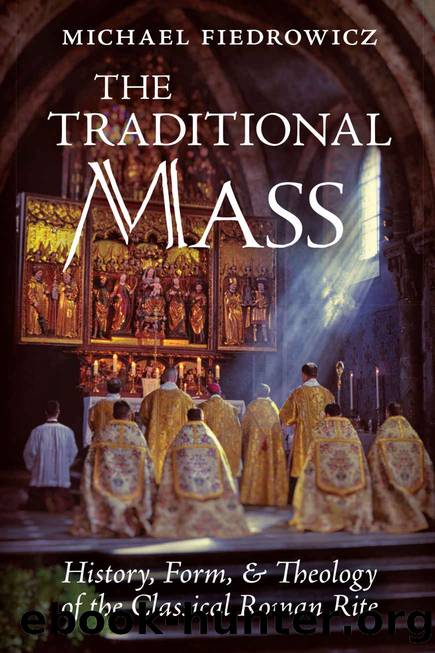The Traditional Mass: History, Form, and Theology of the Classical Roman Rite by Fiedrowicz Michael

Author:Fiedrowicz, Michael [Fiedrowicz, Michael]
Language: eng
Format: epub
ISBN: 9781621385259
Amazon: B08B45SSZM
Publisher: Angelico Press
Published: 2020-06-11T07:00:00+00:00
Gregorian chant
Formation
Gregorian chant is the unison liturgical song of the Church in the Latin language, generally unaccompanied by musical instruments. Its treasury contains thousands of songs that developed over the centuries. For the majority of these pieces, the names of the composers are as little known as the exact time and the exact place of their origin. Precisely because the concrete origin of these hymns remain concealed under the veil of anonymity, Gregorian chant was able to become the song entirely belonging to the Roman Church.96
Although the Gregorian repertoire only emerged in the mid-eighth century, its roots reach much further back into the past. The psalm singing of the synagogue as well as the example of Christ and the Apostles, who also recited the designated number of psalms in the Upper Room, form the oldest foundations of Christian cultic singing. It soon borrowed certain elements from the secular musical art of the Greeks in order to gain form, shape, and beauty.
Gregorian chant, in the strict sense, was the result of a merging of Roman and Gallico-Frankish traditions, which at the same time also took place on the ritual level in the form of the so-called Roman-Frankish mixed liturgy. The center of that fusion during the eighth century lay between the Rhine and Moselle Rivers, in the region of Metz, the heart of Carolingian Europe. While the Roman liturgy here principally contributed the textsâmostly taken from the Bibleâthe core of the Gregorian melodies originates from the Gallican tradition. Though the old Roman liturgical music was certainly rich in its texts, expressing in a fitting way the mysteries of particular feasts through carefully chosen words of Scripture, it remained from a musical standpoint rather poor, extremely sober, and monotonous. The old Gallican liturgical music, on the other hand, with regard to content, was partly characterized by oriental influence, with its poetic exuberance occasionally less exact and diffuse on the doctrinal level, but musically rich, magnificent, and splendid. Thus Gregorian chant in its original inventory was the fruit of a union in which two currents of tradition combined their respective best attributes: from the Roman tradition the quality of text, and from the Gallican tradition the beauty of the music.97 Although the basic principles of Roman chant were preserved, the Gallican musicians provided it with the decorations with which they were familiar. Rome, in turn, recognized this further-developed chant as its own property and adopted it into its liturgy.
As a consequence of this fusion, the basic components of the chant of today emerged during the second half of the eighth century in the northwest of Frankish Gaul. Afterward, the Gregorian style of singing spread throughout all of Europe in the ninth century, quickly replacing all remaining chants by reason of its exceptional quality. The Emperor Charlemagne promoted this development, as he considered the Roman chant to be a unifying factor that gave his empire and the people belonging to it a cohesiveness that was oriented toward Rome, the center of this unity. The
Download
This site does not store any files on its server. We only index and link to content provided by other sites. Please contact the content providers to delete copyright contents if any and email us, we'll remove relevant links or contents immediately.
Christian Ethics for a Digital Society by Kate Ott(724)
Fearfully and Wonderfully Made by Philip Yancey & Paul Brand(704)
The World from 1450 To 1700 by Wills John E.;(655)
God and the Multiverse by Victor J. Stenger(615)
Numbers by Ronald B. Allen(578)
How to Read Slowly by James W. Sire(560)
Christian Ethics: An Introduction to Biblical Moral Reasoning by Wayne Grudem(557)
Morality by Jonathan Sacks(511)
Monastic Archaeology by Unknown(494)
The Technological System by Jacques Ellul(482)
The Disabled Church by Rebecca F. Spurrier;(470)
Jesus: A New Vision by Whitley Strieber(468)
Amish Grace by Donald B. Kraybill & Nolt Steven M. & Weaver-Zercher David L(466)
Children of Lucifer; The Origins of Modern Religious Satanism by Ruben van Luijk(458)
Death of the Doctor by Unknown(451)
Critical Writings by Joyce James;(450)
Redeeming Sociology by Vern S. Poythress(441)
The City of God by Saint Augustine & Marcus Dods(439)
The Church in the Early Middle Ages by G.R. Evans(421)
